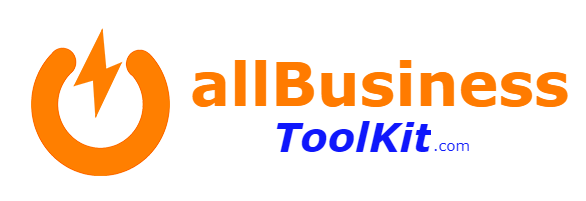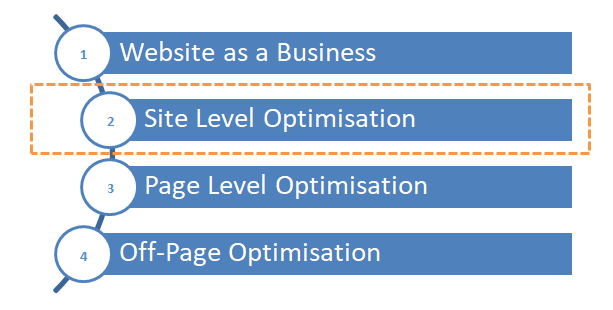Having a business background, I am always thinking strategy.
To build a strategy quickly and effectively I need to have access to all relevant information and have it right at my disposal.
This is also the same for SEO Site-Level optimisation as a whole.
Site-Level SEO is one of four key areas you want to leverage to enhance your websites ranking in search engines results page. Site-Level SEO refers more specifically to those activities that are affected across your whole website.
In this article, I have put together a breakdown of all the site level factors that can influence your search engine ranking.
1. What is Site Level SEO?
Site-Level SEO is also referred to as technical SEO due to its technical nature.
As discussed above, Site-Level SEO is referring to the all the web pages that are effected globally across your website.
The things that are that are duplicated across the website is the header section, menus, domains, server loading speed, mobile responsiveness and sidebars.
These things provide the overall structure and storage to the whole website.
Site-Level optimisation is one of four considerations for SEO marketers outlined in the below image.
1.1 Four pillars of SEO
2. Why is Site Level Optimisation Important?
I am sure you know that the structure of the website, loading speed and mobile responsiveness are MASSIVE factors for user experience.
53% of mobile users abandon any website that takes longer than 3 seconds to load.
If that website is not mobile friendly after the long wait then these users will not be returning to your website.
These all happen globally and there is certain things that need optimising which is discussed below in this article.
3. Root Domain Level Factors
A Root Domain is the top hierarchy of a sites websites URL, as demonstrated in the below image.
3.1 The domain structure for website
In this section, I will outline all of the considerations you need to be aware of when doing your site level optimisation.
3.2 Domain age
The age of a domain is not anything a digital marketer can control.
However, Google do regard it as a ranking factor.
Google former software engineer Matt Cutts states: “The difference between domains that’s six months old versus one year old is really not that big at all.”
What Matt is suggesting in this statement is that domain is a ranking factor. However, Google do not deem this as very important.
I think Google do not want to trust new websites that popup for short time periods.
As these are usually black hatting (breaking the rules to rank).
Therefore, to try to prevent those nasty black hat SEO strategists those re-create spammy illegitimate websites daily.
Thus, you need to consider a more long-term solution for your website.
3.3 Domain registration period
The period that you register your domain for could be a ranking factor according to the Search Engine Journal. As Google’s patent stated, they look at both renewals and date of expiration.
This means if you are purchasing a new domain (that you are 100% happy with), then you may consider having the licence for 5-year period.
This tells Google that you have long-term intentions with your website. Thus, is another measure to distinguish between legitimate and illegitimate website.
3.4 Purchasing used domains
Google stores the history of each domain even after a new owner has purchased it.
This is problematic if that previous domain has been penalised.
Google webmasters explain even though it is the new owner can inherit a new owner the penalty.
However, there are instances whereby Google reset the history under rapidly changing ownerships.
This is something to be mindful of when deciding to purchase an old domain.
3.5 Keywords that appear in the ROOT domain
According to BRANDED3 by having the keyword in the root domain is a small ranking factor.
However, it is very hard to make use of and you can only have one keyword in here, so it is best to prioritise for high priority keywords such as your business name.
It is important to note when optimising the subject path, then the keyword has to appear as this provides a better experience when your page appears in the SERPS.
This is an On-Page level factor… Click here to learn more about On-Page SEO
3.6 Keyword that appears in the SUB domain
A keyword that appears in the sub domain is a ranking factor according to MOZ.
3.7 A country code top level domain CCTLD extension for geographic location
Top-level domain (TLD) is an extension of the URL domain that outlines which country your website is from (such as .cn .jp).
Having a CCTLD is a ranking factor for that particular country. However, it could harm your ability to rank globally.
There is some speculation to which domain to purchase, which provides you with both the highest chances globally and locally.
This is why the Dot com domains are in high demand as they perform better on a global level.
However, if you offer product and services that are focused in local region then by adding CCTLD would improve your ranking over competition that is more global.
Overall, Google wants to move towards more local searches for businesses offering products and services, as it is more relevant to the user making the search.
So, if you have a blog then it is probably best to purchase the domains for all English speaking countries, for the highest results.
3.8 Making your Private ‘Who Is’ settings public
By hiding your privacy, services may deem your website as less trustworthy than those sites that do have their Who Is privacy turned on.
According to Matt Cutts, this is suspicious to do so if you have nothing to hide.
3.9 Website registrants that have been penalised
If you decide to make your Who Is public and it shows you have websites that have been previously penalised.
There is some speculation that Google penalises all websites that are associated with this person.
3.10 Changing domains, Google search console and canonicals
If you have created a new page, which is somewhat of a duplication of the old page, then you want to point the canonicals of the old page to the new page.
If you are installing a new domain as the primary domain, all your links will change.
When you get everything linked up again and working, with all the bugs fixed you will realise a major problem.
That is that Google will not index the new pages because they are duplicates of the old one.
There are three steps for fixing this problem:
Step 1: You want to go to Google search console of the old domain and under the cog-icon and click change of address.
OR, use this link: https://www.google.com/webmasters/tools/change-address
Step 2: Redirect all the old URLs to the new URLs
Step 3: Point the canonicals of the old page to the new page
3.11 Message of the Root Domain
the five things you must know before purchasing your first domiain
- sounds genuine
- not based around a product
- easy to understand
- easy to remember
- triggered to click
- trustworthiness of click
4. Technical, Server and Security Level Factors
- Server response time
- Leverage browser caching
- Defer parsing JavaScript
- type a server
4.1 Security and Secure layer socket (SSL)
Google take security very seriously.
This is because in their search engine they are recommending site to their users.
If they recommend a site whereby the users are not protected can look bad on Google, and they have a reputation to protect.
By using, an SSL Certificate will secure a visitor through HTTPS.
4.2 Site downtime
Google have said that if your site suffers from a lot of downtime, then they will un-index your whole site.
Downtime can be anything from maintenance or server issues, whereby users fail to access the page they are trying to visit.
This is usually down to high amounts of traffic that that the server bandwidth cannot handle.
It is crucial to ensure you are with a decent hosting provider.
4.3 Location of your server and loading speed
The location of the server can rank your site better for geo-specific searches.
Mainly, because it enhances the speed of a search.
4.4 Silo structure
If there are, many different purposes a website serves it can be very unclear for Google to interpret the main theme of your website.
This may harm your overall SERP.
It is advised to create a niche site for this very reason.
Google wants to deliver the best information to its users and if it thinks your website is an array of unrelated information it will punish you as a result.
Google will begin to trust your site keyword relevancy and reward you with rankings as it can thematically organise your content.
4.5 Sitemap
According to Google, a sitemap provides visibility to bots and crawlers.
It helps google to understand how the pages on your website are organised.
This makes Google bots and crawlers to find newly published and updated content through the links the pages provide. Without a site map newly added content might not get indexed.
4.6 Usability
Google measure this by the factors in its algorithm named Rankbrain.
A website that how low usability will have a low amongst of other viewed pages, the time users spend of the website and a high bounce rate. As once users enter the site, and are unable to use it, will leave.
This is measured by bounce rate, exit rate and pogo rate.
4.7 Bread crumb
Google states they use breadcrumbs to categorise information in the search results making it easier for both bots and humans to find their way around a website.
4.8 Contact Us Page
Contact us pages that match the Who Is bio is classed as a trust factor in Google quality document.
4.9 About Us Page
In Googles 200 page document they just released they have stated they are putting more trust in about us pages.
This is because Google do not just base the ranking on the algorithm but they have real people to review it.
If your a specialist in your field then say it in your about us page and it will increase your trust levels.
4.10 Legal Level Factors
Legal documents are not an SEO factor. But, by having a privacy policy, cookie, policy and legal policy does cover you, Google provides you access to their custom search form (SEO clerks).
5. Mobile Level Factors
Google has started to penalise site that are not optimised for mobile users.
If using a CMS such as Umbraco, without a mobile friendly theme it may be the case to upgrade to a WordPress website.
It only makes sense have a mobile friendly CMS theme anyway as more than half of searches are done via mobile (SearchEngineLand, 2018).
Due to mobile sites being loaded via 3G or 4G it is generally not as fast as using Wifi.
In response to this Google are penalising sites that take to load for mobiles (Oko, 2018). So, make sure you site is tested for mobile and desktop devices.
6. Automation Level Factors
6.1 Installing Google Analytics
Having google analytics and their search console installed on your website is considered by some as a ranking factor.
This is because it is able to provide google brain rank more information about your website and its performance (referral traffic and bounce rate ect).
However, google has denied this.
But, it is never any hard having these programs on your site anyway as they provide great insight (Youtube, 2018).
6.2 Installing Google Search Console
To be able to monitor your global ranking abilities then you must install google search console and learn how to leverage it.
6.3 Installing Google Tag Manager
Using Google tag manager to manage your tags can actually improve the speed of your website.
It is always recommended to use Google tag manager if not even for the ease of use.
7. Content Level Factors
7.1 Duplicated content across sites
If your website doesn’t contain original content and not any duplicate. This doesn’t affect your ability to rank if across different websites. However, it will be more competitive to rank. If duplicating content on a competitive niche. The chances are people will never see it in the SERP, according to SearchEngineLand.
This can be ever so tricky for affiliate websites for duplicate product description. So, these types of websites will need to find ways to offer the same affiliate product in a different way. Maybe to specified target audience and re-branding (Google webmaster).
7.2 Duplicate content within the site
Google will penalise a site with duplicate content within the site as this is seen as spam and doesn’t add any value to the user. This includes;
- HTTP and HTTPS
- www and non-www
- Parameters and faceted navigation
- Session IDs
- Trailing slashes
- Index pages
- Alternate page versions such as m. or AMP pages or print
- Dev/hosting environments
- Pagination
- Scrapers
- Country/language versions
- Meta description and title tags
7.3 Updates
When new content is published it gets a slight boost in the rankings and then decreases after some time.
By keeping your content updated not only are you getting this boost, but you are also telling google that you’re actively engaging with your website.
Google does not want to deliver outdated information to their users, and if the majority of pages on your website have not been updated for a while could suggest to google you are neglecting your site.
8. Brand Signal Level Factors
8.1 Anchor text that contain your business name
Anchor text is the words that appear on a hyperlink. By having your business name appear on someone else’s website that links to yours is a good way to build brand recognition and is a ranking factor.
8.2 Search queries for business names and products
If people commonly search for your business name and products, tells Google you are putting effort into building value for your customers.
Otherwise, people will not be looking for you.
This is a ranking factor that shows the legitimacy of your site.
8.3 Mentions of your brand
This includes mentions of both linked and none linked.
If your brand is spoken about, Google will look at this as evidence of a legitimate website.
8.4 Keyword queries alongside your business name
This means that your audience is searching for your business as well as the solution they are looking.
For example, when you search for apple, you may commonly search for ‘apple mobile phones for sale’.
This means it will give a boost to that product (apple phones) in the search engine results page.
8.5 Owning and linking to dedicated social media accounts
If you have built, a solid influence outside your website shows legitimacy for your website.
This can include the amount of shares your posts get and the following you may have.
8.6 Authorship and related expertise
Your website has to be an expertise in the industry you serve, otherwise Google may not trust forwarding people to your page.
In the about us section, it is recommended to share your qualifications, rewards and anything that proves you are an expert in the industry you serve.
8.7 Business Address
Having a real office shows your business is more than just a website.
Conclusion
We have gone over the three types of factors to look out for on-site level. These are domain, technical, architecture and content.





![#50 Top Factors [Link Building & Penalties] For Off-Page SEO #50 Top Factors [Link Building & Penalties] For Off-Page SEO](https://allbusinesstoolkit.com/wp-content/uploads/2019/01/Off-Page-SEO-1.png)

